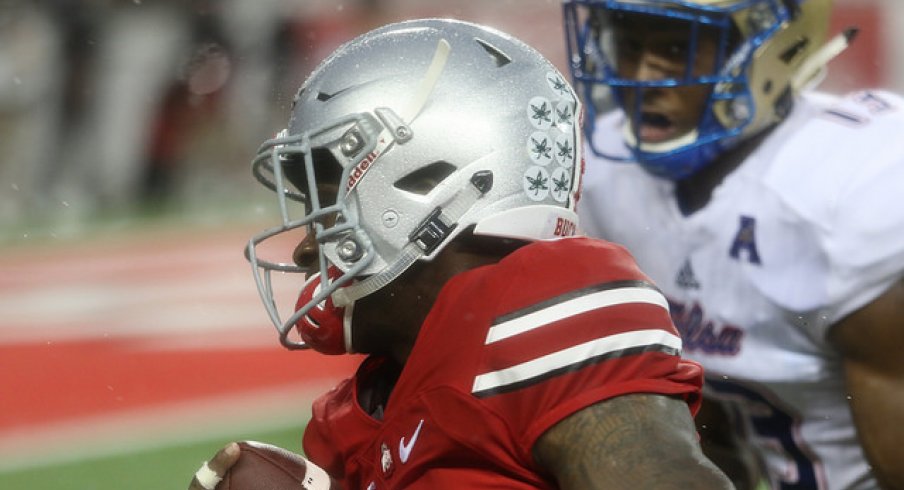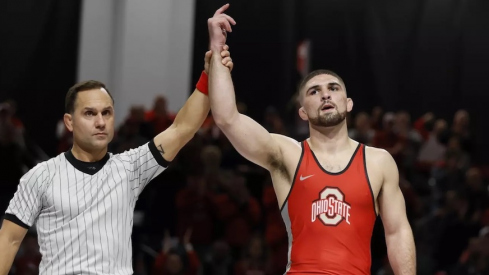Unlike some of the underwhelming performances in the early part of Ohio State's 2015 season, the 48-3 win over Tulsa saw the Buckeyes turn things around after struggling early.
After the offense failed to score a touchdown in the first half, Mike Weber, Dontre Wilson, and J.T. Barrett (twice) found the end zone in the second half of what became a blowout win in inclement weather. But although many were worried about the team's lackluster early performance after lighting up Bowling Green the week before, Urban Meyer seemed relatively calm in his postgame press conference when asked about the subject.
The Buckeyes showed some flashes before halftime, putting together a pair of nice drives that stalled in disappointing fashion, but also served up four three-and-outs and gave away a fumble on a botched handoff, leaving many Buckeye fans unimpressed. In the second half, however, they flipped the script entirely with four touchdown drives and only two punts.
The secret to this change in fortune can be found directly at the line of scrimmage. Unlike the previous fall, in which the Buckeyes worked through an identity crisis schematically, swapping back and forth between Barrett and Cardale Jones at quarterback, this OSU squad knew exactly what they were supposed to be, having seen what they could do the week before.
But every single opponent that Ohio State will face this year will bring their best effort and game plan to the table, knowing that a big performance against Meyer's squad is a way to get others to know their name. Tulsa was no different, and their defensive front seven clearly had no intention of rolling over aginst one of the nation's top five teams.
While the Buckeyes seemed intent on establishing their base, tight zone run concept early, Tulsa seemed plenty prepared for the concept. With three down linemen and at least one outside linebacker walked up as a stand-up end, the Golden Hurricane defense regularly gave the OSU line a four or five-man surface to block.
In addition, the interior of the Tulsa line did an excellent job slanting to different gaps, forcing double-teams and keeping Buckeye blockers from getting to any linebackers on the second level.
First-year starters at tackle Jamarco Jones and Isaiah Prince struggled a great deal more in their second starts than their first, each committing penalties and failing to hold their blocks on critical occasions. But the Tulsa defense wasn't simply winning due to a superior effort, however, as they had prepared for this contest and showed up with a plan the young Buckeye offensive line hadn't expected.
According to Barrett, "They have a good defense over there and they did a good job game planning. A lot of pressure that we weren’t ready for, or one of the pressures we weren’t ready for. With that, just kept us on our toes and our base plays we had a hard time running between the tackles because they were doing a lot of twisting. We made adjustments at halftime and did a better job of picking that up in the second half."
While the Buckeyes didn't try to change the core of the game plan too much during the extended halftime break, they did tweak their approach to running the same play concepts. For instance, when running tight zone in the second half, they often did so out of four-receiver sets, spreading out the Tulsa defense and making Barrett's option read much clearer. While there was one less OSU blocker (no tight end), there were fewer defenders near the line, making it easier for the offensive line to identify responsibilities and achieve the critical second level blocks needed to spring some big runs.
In addition to these subtle tweaks in formation, play-caller Ed Warinner began relying more heavily on the few known commodities in his unit. Weber broke off some nice runs on his way to leading the game in rushing, but the story of the second half was the production from Ohio State's 'H' position, manned by two of the team's most experienced players.
After amassing 261 total yards in week one, Curtis Samuel picked up right where he left off by adding 78 yards on the ground and another 62 through the air as a receiver against Tulsa. But the Buckeyes also saw some big production from Dontre Wilson in the same role, adding 58 yards of his own on only six total touches as both a running back and slot man.
The duo became the centerpiece of the offense in the second half, especially once Warinner began using both on the field at the same time. One way in which he did so was through two-back shotgun formations, often motioning one from the slot just before the snap and handing off on a Jet Sweep.
Not only did runs like these help open up the running game against Tulsa's tough interior, they finally allowed the Buckeye play-action passing game to get going. The key to such an attack is not only that the offense fake a handoff before throwing, the handoff must look one they've seen before. That's exactly what happened as Barrett faked a sweep to a motioning Wilson before eventually finding Samuel wide open on a wheel route after leaking out from the backfield.
Of course, the final bullet in Warinner's chamber was the use of Barrett in the run game. While his 16 carries may have been more than the coaching staff would've preferred to give their star quarterback in an early season blowout, his presence in the OSU running game is critical to its success.
Many of the early struggles seemed to disappear as designed runs for Barrett reset the arithmetic in favor of Ohio State, giving the Buckeyes an extra body to block a crowded Tulsa front. But he was most effective in the option game against the Golden Hurricane, running the speed option outside as well as keeping on tight zone reads.
While the beginning may not have been what Ohio State fans expected, watching all 10 of the young receivers make a catch or seeing young running backs put up huge yards, the final result should be looked at as a positive one given the looming challenge on the horizon. What the Buckeyes showed in the second half is far more likely to be the game plan against a talented Oklahoma defense that has already seen a system like this one in the Houston Cougars, and will champing at the bit to show the world they're better prepared for it this time around.
"We’re not prepared game-plan wise," Barrett answered when asked about the team's readiness for the Sooners. "I feel like today on offense we started a little sluggish but we’re going to get better at that. I think we’ll keep on progressing because in the second half we did a great job playing our offense and our defense did a great job."
Unlike 2015, it's clear what Barrett means by that last statement, as this offense knows where their bread is buttered. Weber will provide powerful inside runs behind a prepared offensive line while Samuel and Wilson stretch defenses on the outside; the whole time with Barrett conducting the show and adding in an additional running threat when needed.
The formula may not be complicated, but it sure can be effective.


